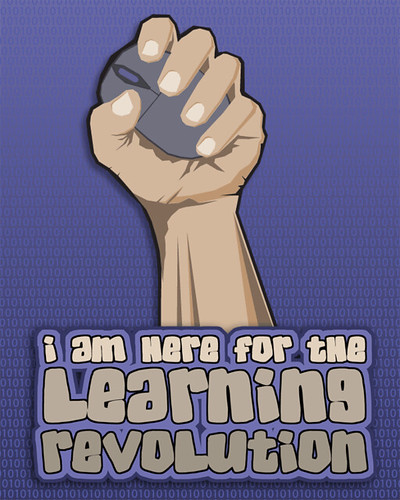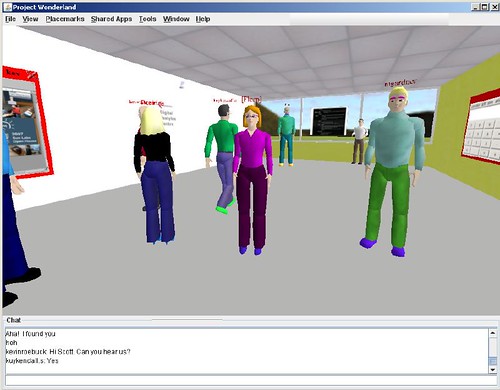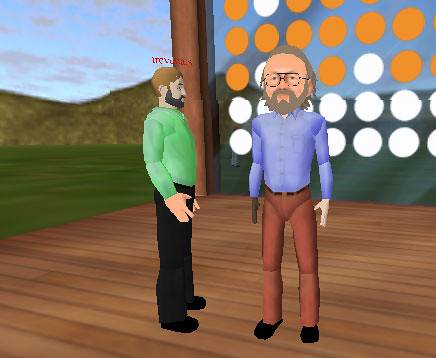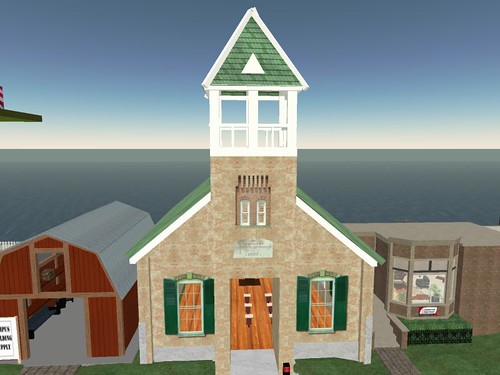I received a request from a colleague I met in Second Life to answer four questions her classmates had about virtual worlds in education. The course is:
University at Albany
State University of New York
ETAP 723: Seminar in Technology, Dr. Peter Shea
Module 5: Pedagogy in a Virtual World – Lorraine Emerick/Speranza Serevi & Kevin Goodman/Raxen Gears
http://www.incubatorisland.com/vworld.htm
They were such great, thought provoking questions that I asked permission to share them on my blog as well, and I’d love to know what YOU think and I’m sure Lorraine/Speranza’s class would as well – please leave a comment and tell me what I got right and where you disagree!
1) What do you see as the benefits and purpose of student socialization (eg. beaches, bars, etc.) in SL higher education courses?
One of the most important benefits of virtual world technology is the ability to “see” when another person is viewing the same content or visiting the same space that you are. In this sense, virtual worlds enable a kind of serendipity, chance encounter, water-cooler effect. If I’ve been assigned a video to watch, I can see when other students in my class are watching the video at the same time, and we can talk about it, discuss it, and form a deeper understanding of the content as well as develop a better network with my classmates. The traditional (or “flat”) web simply doesn’t offer this ability. Social spaces in or near “teaching” spaces in virtual worlds can facilitate this kind of chance encounter and networking effect within the class.
And while traditional students living on-campus are likely to experience the socialization and community aspects of college life, commuter, non-traditional, and distance learning students often miss these important aspects of the university experience. Virtual worlds may enable students with many different lifestyles and schedules to more fully participate in the civic and social life of a university, and perhaps even a greater, more global network than is available on campus, that will have many of the same long term benefits that traditional college networking yields later in one’s career. Having fun and hanging out is an important part of this socialization, one that I don’t think is any different in virtual environments than real ones.
Finally, I think environments like Second Life can change the “teacher-student” dynamic into.. something more akin to a “guide-learner” dynamic, in part because there can be elements of personal expression or social interaction that aren’t generally present in a traditional classroom. The way a person chooses to represent themselves in avatar form can be quite revealing or entertaining, and the ability to create very un-traditional spaces – whether for teaching or socializing – can facilitate a different kind of interaction between instructors and learners. While some may be uncomfortable with this shift, I think the inclusion of social or experimental spaces that don’t resemble what we think of as “classrooms” will be very key elements as we more fully explore the potential of virtual worlds in education.
Besides, who wouldn’t love to be in class by the beach!
2) What do you think distance learning will look like in 5 years? Do you think popular platforms, such as Blackboard, will have a virtual world presence?
One would think that course/learning management systems like Blackboard would be quick to explore this market, but I’ve seen few examples of this to date. Angel does have an island in Second Life, and Blackboard did award a grant (I believe to Ball State University) to explore some cross-over between the LMS and SL, but beyond that I haven’t seen much activity in this regard. I think the virtual worlds market is still in such an early, emerging phase that it doesn’t rank very high on the priority list yet. We’ll have to see greater adoption by educational institutions and more demand from faculty and students (that trickles up to those who make the purchasing decisions) before the major players will jump into the virtual worlds pool. Another factor inhibiting this kind of development is that most virtual world platforms are proprietary and the underlying technical standards that help different systems talk to each other have not yet been developed for virtual worlds. In many cases, this means that existing learning management systems would have to start from scratch in a new market. We may see more LMSs move towards virtual world integration when these platforms begin to adhere to common protocols that can interface with existing LMS systems.
As for distance learning.. I’ve come to dislike the phrase, since the “distance” component may not be the most relevant factor. Traditional and non-traditional students alike seem to be interested in online course options that accommodate flexible scheduling, and whether a student is 50 miles away or around the world, their distance from the institution shouldn’t really matter when we can offer anytime, anywhere student services and learning opportunities on the web. I have great hopes that virtual world technologies will enhance our abilities to provide top-notch service and instruction to students no matter where they live, whether by helping “distance” students feel more connected to others in the course through the sense of co-presence in virtual worlds, or by providing another avenue for students to connect to the institution in a more visually rich and appealing way than the flat web allows.
Having said that, it seems from my experience that what we generally think of as the distance learning student population often has less technical experience and access to fewer high end technology resources than traditional on-campus students, so I think accessibility and digital divide issues will continue to be a significant challenge to overcome since virtual worlds generally require high end computers, graphic cards, and high speed internet access. It’s a sad irony that the very populations who might most benefit from this technology might also be the least likely to have access to it. I don’t imagine those kinds of issues will be resolved in the next 5 years, but I hope that early pilot programs exploring the potential of virtual worlds for distance ed will help provide data that will bolster the arguments for more technology and infrastructure spending throughout our educational and library systems.
3) As the younger generation (today’s users of Webkinz or Club Penquin) age, do you think universities will market virtual world learning to compete for students? Is this happening now?
I have no doubt whatsoever that the “web” will become more spatially oriented in the coming years, and I certainly hope that educational institutions will play a key role in not only developing the technology that will facilitate it, but also leverage its advantages to attract a wider population of students. Based on recent reports I’ve read (there are several good, recent studies from the Pew Internet & American Life Project at http://pewinternet.org/), it certainly seems that students want more technology integration into their academic experiences, so I imagine that institutions who can offer cutting edge services will have a competitive advantage – and certainly in the current climate, anything resembling a video game is probably more appealing than dry boring text on a website.
We see the beginnings of this already with examples like Case Western Reserve’s “Campus Tour in Second Life” program that brings high school students on virtual campus tours (http://admission.case.edu/secondlife.asp) or MITs student “pod design” competition, where students were invited to create their own personalized student spaces. That experience led to some discussions about the possibility of creating virtual dorms that incoming freshmen could decorate and maybe even meet their roommates and fellow residence hall classmates in advance of arriving on campus. I think that’s a pretty creative way to help students transition to college! The incentive is certainly there for universities to offer more engaging and creative ways for potential students to interact with the institution, and students seem to want it, so I think we’ll see even more examples virtual worlds being used as recruitment vehicles in the coming years.
4) Teacher presence in virtual worlds are critical to a successful learning experience. How do teachers in virtual worlds compare with those in more traditional asynchronous distance learning settings? How receptive do you think teachers are to teaching in virtual worlds?
I’m not sure exactly what is meant by teacher presence in the first sentence. Do you mean that successful learning experiences can’t happen without an instructor’s involvement? If so, I would have to respectfully disagree, but I think this question gets at the heart of something that is so crucial to the promise I see in virtual worlds, and yet it is something I also find very hard to articulate. I’ll try to address the other questions and maybe will end up circling back to the first.
It’s almost unfortunate that we talk about and think about virtual worlds as a kind of “technology” application, rather than talking about them like an exciting new laboratory, or as giant sandboxes, or as a way to step into our collective and individual imaginations. Learning new technologies can be stressful, confusing, and scary and particularly when you factor in public hysteria about the dangers of the internet to children, I can see why many teachers would approach something as fantastical as virtual worlds very warily indeed. And yet, it is the educational community in Second Life that has plunged headlong into exploring it most fully (Co-Founder of Second Life Says Academics Are Biggest Trailblazers in Virtual Worlds – http://chronicle.com/wiredcampus/index.php?id=2983&utm_source=wc&utm_medium=en), and from my personal experience, it seems that virtual worlds are attracting _not_ the most tech savvy faculty and staff, but rather the most _collaborative_ faculty and staff.
Many of course do have previous experience with teaching online, and there’s a higher “tech savvy” quotient overall, but despite every conceivable obstacle under the sun – from lack of funding and suitable infrastructure, to skepticism and sometimes outright hostility from administrators, to worries about leading students down a prim-rose path to online addiction, to fears about inappropriate content and intellectual property rights and a general confusion about the legalities of digital content – despite all of these challenges, I see educators from all over the world coming into this environment and becoming fascinated with its potential. There is resistance and fear, but I also see a staunch determination to not let these obstacles and fears stop their exploration of a technology that appears to have so much potential. If anything, I see the teachers involved in virtual worlds today as no different than the instructors who pioneered web based distance learning programs and fought the same battles 10 years ago. I’d like to think that we are all continually seeking ways to improve learning outcomes, regardless of the platform.
And that does bring me back to the first sentence – I hope in our seeking and exploring, that we will be open to the idea of facilitating learning experiences that do _not_ require the presence of a teacher. So much of my experience in Second Life has been entirely self-directed learning, with no formal instruction, no rubrics, and the only assessment was my own – did I do a good job? Do I feel satisfied by how I just spent my time? Do I still have more questions?
I think that our modern educational system is in so many ways completely disconnected from the real world, from authentic experiences, with personally felt repercussions for failures. So many younger students simply don’t see the point, because they don’t feel they have any stake in the outcome. But part of the enchantment of virtual worlds is the ability to _play_, to practice, to pretend, to be creative and imaginative, and to do things that we don’t or can’t or can’t yet do in real life. I’ve come to see virtual worlds as sitting within an ecosystem of web and social media technologies that enable so many different learning styles, so many opportunities for “just in time” information, so many opportunities for self-directed learning, that I hope teachers will learn to leverage this technology in ways that do allow students to learn without them. Knowing when and how to intervene, provide assistance, or develop structures that guide the learning experience while still enabling the kind of personal autonomy that deepens a student’s sense of investment in the outcome is key to helping students become life-long learners – and isn’t that part of the goal?
Many thanks to Speranza’s class for providing such terrific questions! (Update: Minor edits and corrections.)

















